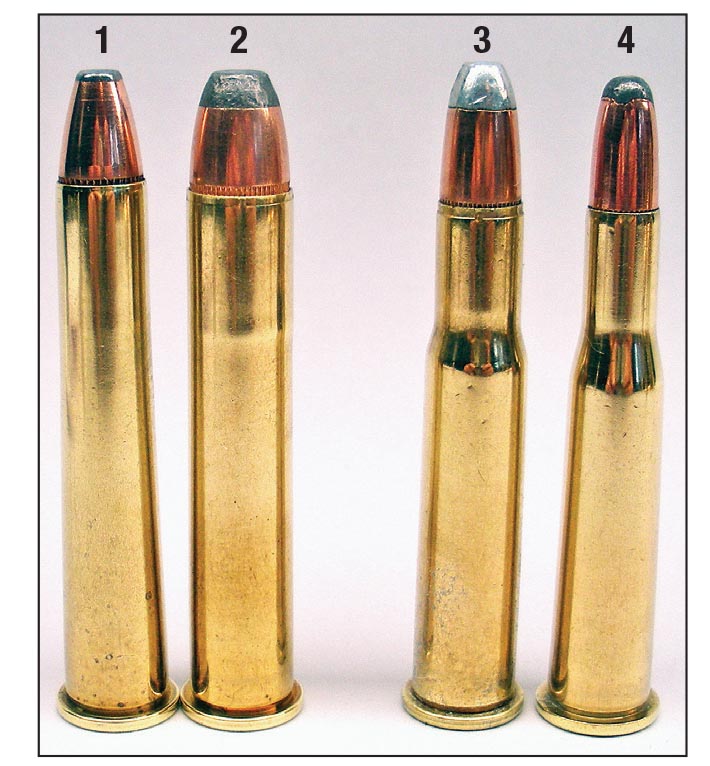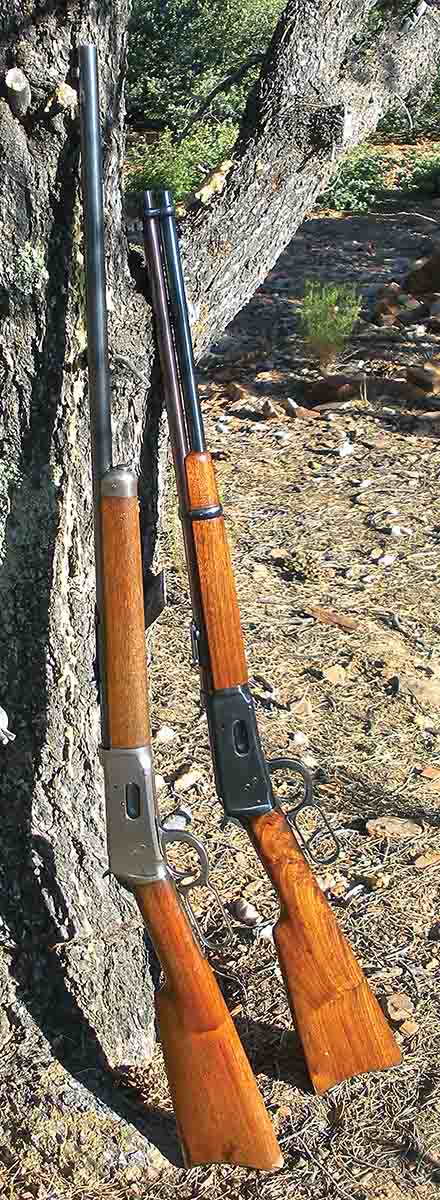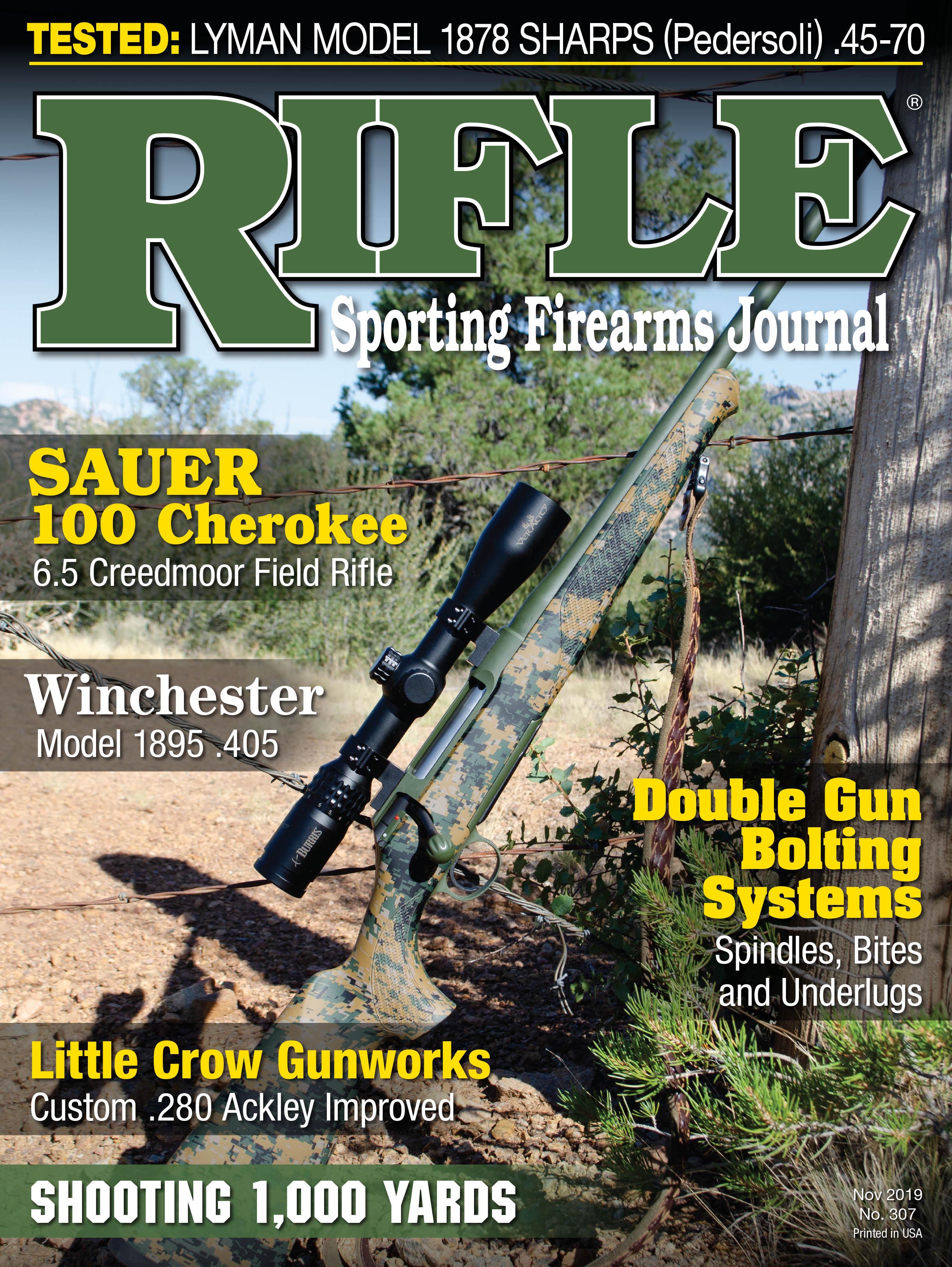Spotting Scope
The Year Was 1969
column By: Dave Scovill | November, 19

To speed things up a bit for cleaning revolver cylinders, an oversized .45-caliber (.45-70) brush, for example, attached to a short extension and mounted on a portable drill, is used to hone .457-inch diameter .44-caliber chambers. A .475/.480-caliber brush works to clean up .45 Colt and tapered .38 and .44 WCF chambers. When firearms pass inspection, they are set aside for a light oiling, very light, since the Arizona climate is relatively dry and the safe doesn’t allow much, if any, moisture to seep in anyway.
Cleaning Marlin leverguns is simplified by removing the lever pivot screw, then the lever and pulling the bolt out from the rear. The barrel and chamber are easily cleaned from the breech end with the oversized brushes mentioned above for respective calibers.
The removal of Winchester lever-action bolts requires a more detailed description, but with the lever down, it is easy enough to run a cleaning rod, sans brushes or patches, down to the breech end and attach an oversized chamber brush; the muzzle end of the rod is attached to an electric drill. Pull back on the drill to scrub the chamber. Using a bore guide, clean the barrel from the muzzle end first, to avoid pushing crud into a clean chamber.
I’ve used Lyman’s Butch’s Gun Oil almost exclusively for several years to clean up older but serviceable firearms. It doesn’t goo up the works and helps lift rust out of minor pits on elderly previously neglected guns, several of which are near, at or over a century old and have passed into my hands in the last 40 years or so.
Toward the end of what usually ends up as a two-day marathon cleaning effort, it was discovered that there are more .44 WCF rifles, carbines and handguns than any other caliber. How that happened I’m not sure, but it appears to have started in 1969. That’s about the time Winchester finally got a few of those Model 94 .44 Magnums into Oregon. I bought the first one that showed up at a local gun show.
For those who may not be aware, the receiver of Winchester’s post-1964 Model 94 .44 Magnum was fashioned from some sort of mystery metal that refused bluing of any sort and was finished with a black oxide. The rest of the metal – barrel, loading tube, lever and lower tang – were blued, nearly black. The bobbed-off forestock and buttstock were fashioned of some sort of mystery wood. The buttplate was flat checkered steel, perfect for cutting a chunk of hide off your shoulder when wearing a light shirt while shooting in warm weather.

The multi-groove barrel with a 1:38 twist didn’t shoot all that well until I tried 200- to 220-grain jacketed softpoints or hollowpoints driven to optimum velocities from the 20-inch barrel. Groups at 100 yards with 240- to 250-grain cast bullets are politely called clusters, about the size of a three-pound coffee can, with jacketed versions doing only slightly better. Either way, it was the Winchester Model 94 .44 Magnum that launched my interest/curiosity in all things “.44,” including handguns, carbines and rifles. Not to the exclusion of other calibers, etc., but the .44s formed the foundation for a study of firearms most writers avoid like the plague.
Regardless of the appearance and pedigree of that carbine, it saw quite a bit of use until I found a circa 1917 .30 WCF carbine. Marlin also came out with its Model 94 chambered for the .44 Magnum. Eventually I found one but owing suspect accuracy, sold it to a friend who just wanted to shoot rocks and cans.
Besides .44s, two of the favorite Winchester Model 94s are a carbine and rifle chambered for the more or less famous target cartridge, the .32-40 Marlin/Ballard/Winchester that was one of the introductory cartridges with the Model 94, along with the .38-55. I’ve never seen a .32-40 with a nickel-steel barrel proofed for smokeless powder, and some collectors claim there weren’t any, since both cartridges earned their stripes in single-shot, black-powder rifles prior to being added to Winchester’s Model 94 lineup.
On the other hand, the nickel- steel proof on .38-55 barrels is not rare, but barrels that measure the proper diameter of .376/7 inch are, ranging from .377 to .381 inch or so. As such, assuming the use of factory loads with .377-inch jacketed bullet diameters, accuracy can be excellent in one rifle, terrible in the next. A favorite Model 94 .38-55 is a Legendary Frontiersman commemorative with .377-inch barrel grooves that produces minute-of-cottontail accuracy with factory loads or the RCBS 37-250-FN sized to .381 inch and seated over 16.5 grains of 2400, averaging just under 1,500 fps. The RCBS slug sized to .381 inch shoots well in oversized barrels as well.
Velocity of current Winchester .38-55 factory loads with 255-grain jacketed bullets is little more than 1,000 fps, despite the factory claim of 1,300 fps from a 24-inch barrel. Even at those pedestrian speeds, however, it will shoot through a Texas whitetail. To my knowledge, there are no currently available factory .32-40 loads, so handloads feature the RCBS 32-160-FN bullet loaded over 15.2 to 16.4 grains of H-4227 for 1,600 to 1,700 fps, respectively, and sub-MOA accuracy. Jacketed bullets designed for the .32 Winchester Special have the crimping cannelure a bit too far to the rear and require an additional cannelure to locate the crimp and achieve proper overall loaded length. Huntington’s and Buffalo Arms Co. stock brass.
Some gun-scribes have questioned why Winchester chose to introduce the Model 94 with two, about to be seriously outdated, black-powder cartridges. First, they weren’t just old black-powder cartridges but were collectively the soup du jour of target cartridges that were never really challenged well into the smokeless-powder era. Some of the records for the .32-40 still stand. Keep in mind target shooters of the day stood on their hind legs, which makes those black-powder records all the more remarkable.
So it wasn’t just a matter of waiting a year for the addition of the nickel-steel barrels to introduce the smokeless cartridges; the initial unveiling of the Model 94 was a purposeful effort to appeal to the well-established, black-powder market for two of the most popular calibers of the period, then the followup with the soon-to-be revolutionary smokeless .30 and .25-35 WCFs. The net effect was to corner the market for sporting rifles and cartridges of the day in repeating rifles, leaving Marlin, Ballard, Remington and others in an almost futile effort to catch up.
In my meager collection of Model 94 rifles and carbines there is also a Model 64 .32 SPL Deer Rifle, a Model 94 octagonal barreled .25-35 WCF rifle, a .25-35 WCF carbine and a well-worn, but not abused, .30 WCF carbine stocked with mystery wood, referred to as “gum wood” in some references.
The bulk of the lever actions are Model 73s, mostly .38 WCFs (aka .38-40). With the exception of two, the remainder are .44 WCFs (aka .44-40). The .38 and .44 WCFs get little respect lately, except for inclusion in some self-anointed grave digger’s list of favorites. In spite of the bum’s rush the .38 WCF receives from the unwashed, it is actually a fairly good cartridge that routinely produces somewhat better accuracy than its stable mate .44 WCF and is easily capable of knocking a big coyote over at responsible ranges, say 100 to 125 yards, for folks who can shoot with open sights. That is to say, whatever shortcomings the .38 and .44 WCFs might suffer in the minds of some enthusiasts, it is not the fault of the rifle, carbine or cartridge. The fact that a good number of these older firearms show the effects of extensive use should at least suggest they not only invited that kind of use, but also held up to it, and many have survived in shootable condition for well over 100 years.
There are also a few Winchester Model 92 .38 and .44 WCFs that range from well used to like new, albeit most shoot well enough for hunting coyotes, foxes, badgers, bobcats and lions, most of which are classified as furbearers.
One of the talking points that has been used to excess over the years is that these old black- powder-era cartridges are not, or barely, suitable for hunting deer-sized game. It stands to reason that folks who make those claims would never hunt deer with them, and by default, lacking any first-hand experience to draw from or blood on their hands, the claim has no credibility. When so-called experts exude that sort of drivel, it makes you wonder how humanity survived until smokeless powder and scopes were invented.


